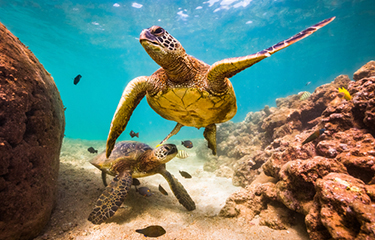NOAA Fisheries has proposed designating critical habitat areas for endangered Rice’s whales and green sea turtles as part of its efforts to ensure the species’ survival.
The Rice’s whale critical habitat proposal is part of a settlement between NOAA and conservation groups Healthy Gulf and the Natural Resources Defense Council, which sued the government for failing to designate critical habitat for the whales within the time required under the Endangered Species Act.
“Because the Rice’s whale doesn’t migrate like other large whales – the entirety of the whale’s known habitat lies within United States territory – their survival as a species falls on U.S. shoulders,” NRDC Marine Mammal Protection Project Director Michael Jasny said. “This critical habitat designation is a step in the right direction; Now we need to roll up our sleeves and do the work to actually save the whales.”
Found only along the continental shelf in the Gulf of Mexico, Rice’s whale habitat “has been degraded by oil and gas development,” according to NOAA Fisheries. There are only about 50 Rice's whales left, and in 2022, 100 scientists signed an open letter to U.S. President Joe Biden warning that significant action was needed to preserve the whales from extinction.
“As we’ve come to recognize the tremendous ecological value that whales provide, it’s clear they are a bedrock for productivity in the open ocean,” Healthy Gulf Florida and Alabama Coastal Organizer Christian Wagley said. “With the Rice’s whale down to such a small population, large areas of the Gulf of Mexico are being starved of the many benefits these whales provide."
NOAA Fisheries is also working with the U.S. Fish and Wildlife Service on designating critical habitat for green sea turtles on the land and in the sea.
“Green sea turtles continue to face threats in the marine environment, including human interactions like bycatch and marine debris, as well as habitat loss and the ongoing impacts of climate change,” NOAA Fisheries Assistant Administrator Janet Coit said. “These new critical habitat proposals will aid in our joint mission to protect and recover endangered and threatened green sea turtles.”
Under the proposal, 8,870 acres of land where turtles are known to bask, nest, and hatch would be designated, along with migratory corridors, feeding and resting areas, Sargassum habitat in the Gulf of Mexico and Atlantic Ocean, and waters used to access nesting beaches. Those areas are spread across the states of California, Florida, Hawaii, North Carolina, and Texas, the territories of American Samoa, Guam, and U.S. Virgin Islands, and the Northern Mariana Islands and Puerto Rico. Much of the habitat overlaps with areas already designated as critical habitat for other species, according to NOAA Fisheries.
The government will be hosting virtual and in-person meetings and hearings on the proposal. Comments on the green sea turtles rules are due by 17 October.
Photo courtesy of Shutterstock / Shane Myers Photography







